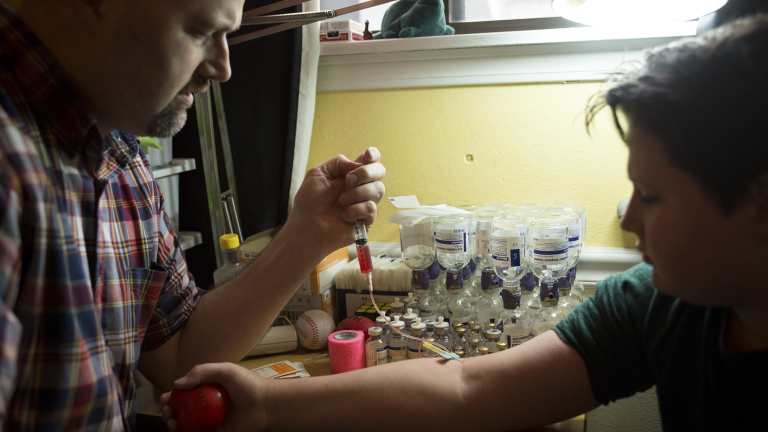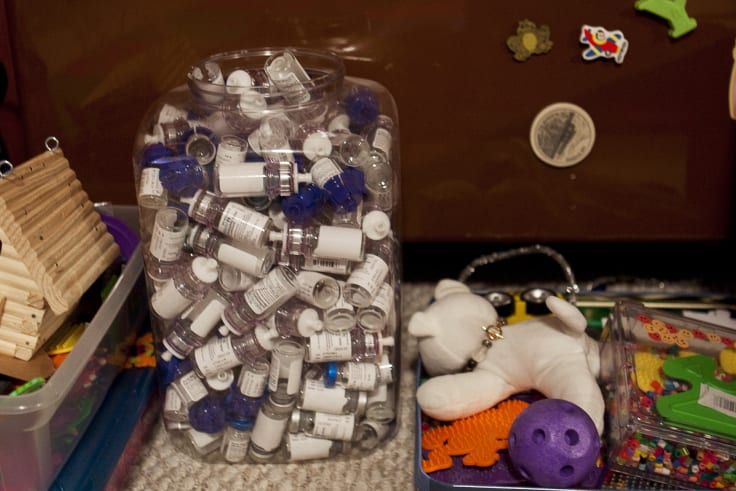Scientists are edging closer to defeating a longtime enemy of human health: haemophilia, the inability to form blood clots.
After trying for decades to develop a gene therapy to treat this disease, researchers are starting to succeed. In recent experiments, brief intravenous infusions of powerful new treatments have rid patients – for now, at least – of a condition that has shadowed them all their lives.
Bill Konduros, left, and his brother Jay walk at a park in Mississauga, Canada. After managing their haemophilia for their entire lives, the Konduros brothers appear to have been cured by gene therapy.
There have been setbacks – years of failed clinical trials and dashed hopes. Just recently a biotech company reported that gene therapy mostly stopped working in two of 12 patients in one trial.
But the general trajectory has been forward, and new treatments are expected by many experts to be approved in a few years.
No one is saying yet that haemophilia will be cured. Gene therapy – which uses a virus to deliver a new gene to cells – can only be used once. If it stops working, the patients lose the benefits.
For now, "we are anticipating that this is a once-in-a-lifetime treatment", said Dr Steven Pipe, director of the haemophilia and coagulation disorders program at the University of Michigan and a lead investigator of a clinical trial conducted by the biotech company BioMarin.
The successful treatments are so recent it is hard to say how long they will last. But for the few patients who have been through the clinical trials successfully, life after treatment is so different that it's something of a shock.
Nathan Wilkes performs an intravenous infusion of clotting factor concentrate for his son, Thomas, who has haemophilia, in Englewood, Colorado.
There are 20,000 haemophilia patients in the United States who lack one of two proteins needed for blood to clot. It's a genetic condition, and the gene for blood clotting sits on the X chromosome. Virtually all people with haemophilia are men.
Those most severely affected must inject themselves every couple of days with the missing proteins, clotting factor VIII or factor IX. The shots keep haemophiliacs alive, but levels of clotting proteins drop between injections.
Even with regular injections, people with haemophilia risk uncontrolled bleeding into a muscle or joint, or even the brain. They must be extremely careful. Once bleeding begins, a joint may bulge as the joint space fills with blood. When the bleeding stops, the joint may be damaged.
Even a routine flight is risky, said Mark Skinner, a 57-year-old attorney in Washington with haemophilia who is a past president of the World Federation of Haemophilia.
A collection of empty bottles of haemophilia medication at a home in Falmouth, Maine.
"Carrying luggage around, you can twist the wrong way and immediately trigger a bleed," he said. "Or you can get hit with a cart going down the aisle."
People with haemophilia often are taught as children to avoid most sports and to find professions that will not require much physical activity. Many move to cities to gain easier access to treatment.
They may change jobs to get insurance needed to cover medical bills for hospitalisations and surgeries that can reach $US1 million ($1.36 million) a year, plus an average $US250,000 to $US300,000 a year for the clotting proteins. (The shots alone can cost as much as $1 million per year.)
Despite their vigilance, most with severe disease eventually develop permanent joint damage from bleeds, often leading to surgery for ankle fusion or hip or knee replacements at an early age. Most live with chronic pain from past bleeds.
Imperfect Successes
The goal of gene therapy is to reduce or eliminate patients' need for injections with clotting factor and to reduce the number of bleeds. The gene to be inserted depends on whether the patient has haemophilia A, caused by a mutation in the gene for factor VIII, or haemophilia B, caused by a mutation in the gene for clotting factor IX.
Although the symptoms are the same with both forms of the disease, haemophilia A is by far the most common.
A handful of biotech companies are now rushing to get their gene therapies to market. Spark, with gene therapy for haemophilia B, and BioMarin, another biotech company, with a similar treatment for haemophilia A, are starting large, final-phase clinical trials. (Spark is partnering with Pfizer.)
Results from the two companies' preliminary trials were not perfect.
Austin Caldwell, whose drug treatments for haemophilia cost more than $US1 million a year, during a doctor’s appointment in Charlotte, North Carolina, in 2015.
Patients in Biomarin's haemophilia A trial got, on average, normal or above-normal levels of factor VIII in their blood, but in the second year, those levels dropped to a median of 46 per cent. It's not clear why.
Patients in Spark's haemophilia B trial only reached on average 35 per cent of normal blood levels of factor IX. But those levels have remained steady for the two years they have been followed.
The good news is that those levels are sufficient for blood to clot, because normal levels are more than people need.
A Lucky Mutation
At first, haemophilia seemed ideal for gene therapy.
Normal blood levels of clotting proteins range widely, from 50 per cent to 150 per cent of average. A gene therapy for the disease would not have to provide much to be effective for patients.
And researchers knew just which genes to insert into patients' liver cells. The genes for haemophilia A and B were isolated in the early 1980s.
But the research proved difficult, and the first positive result was reported just a decade ago by scientists at University College London. They treated 10 patients with haemophilia B and managed to increase their blood levels of factor IX to between two and six per cent of normal.
In those patients, clotting proteins have persisted at those levels since.
Replay
Then scientists stumbled upon an unexpected bonanza. They found a man in Padua, Italy, who had a genetic mutation that made cells churn out as much as 12 times the usual amounts of factor IX.
Investigators realised that they could put the mutated gene into a virus and use it to insert the mutated gene into the cells of patients with haemophilia B.
The advantage was that they would not have to use so much virus – and the lower the dose, the less likely the immune system would attack.
But haemophilia A has been more daunting.
The viruses used to carry modified genes into patient cells are called adeno-associated viruses. They cannot carry a large gene, and the gene for factor VIII, needed to treat haemophilia A, is enormous.
After 15 years of effort, investigators finally discovered they could reduce the gene to a manageable size by slicing out portions that turned out not to be needed.
No longer are scientists and patients dazzled by a treatment that raises blood clotting factor levels merely to six per cent of average. "My thinking has evolved," said Skinner.
The results that companies are reporting now "really seemed unimaginable" just a few years ago, he added.
New York Times
Source: Read Full Article



